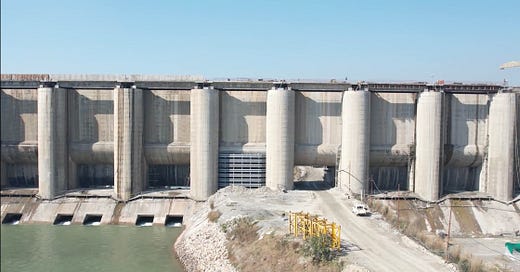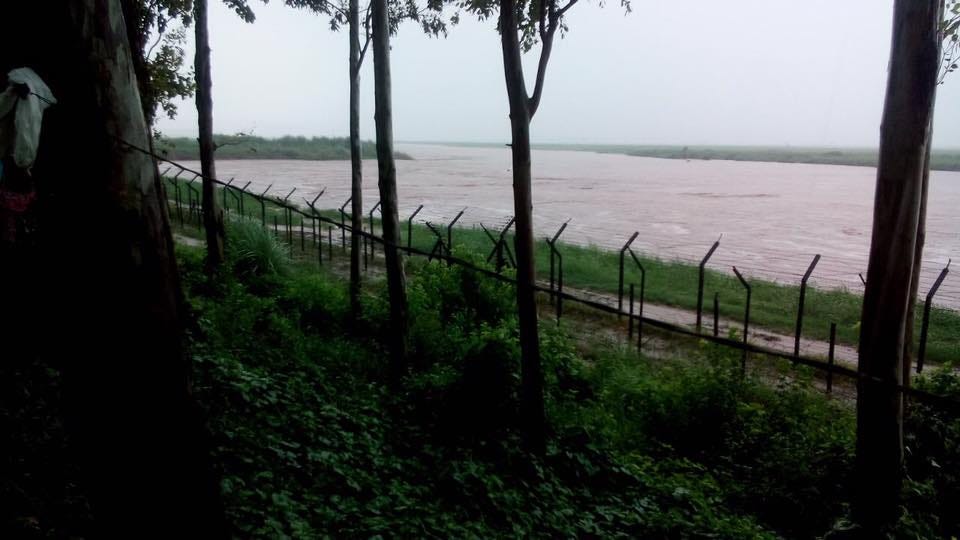Shahpur Kandi Dam on River Ravi Nearing Completion: After Decades of Delay and National Losses
In the execution of mega projects like this, which take decades to conceptualize and implement, small bureaucratic and technical objections can derail the entire project, leading to cumulative delays
A Milestone in India's Water Resource Management
The Shahpur Kandi Dam project is a significant achievement in India's water resource management, aimed at enhancing irrigation and power generation while preventing the flow of Ravi River water into Pakistan. Located in Punjab’s Pathankot district (earlier Gurdaspur district), just downstream of the Ranjit Sagar Dam, this project has overcome decades of delays, disputes, and bureaucratic obstacles to reach its final stage of completion.
Project Overview and Technical Specifications
The Shahpur Kandi Dam is a 55.5-meter-high concrete gravity dam equipped with a 7.70 km long hydel channel, two head regulators, and two powerhouses with a combined capacity of 206 MW. Designed to function as a balancing reservoir, it will regulate water releases for irrigation and hydroelectric power generation, supplying 1,150 cusecs of water to irrigate 32,173 hectares in Jammu & Kashmir’s Kathua-Samba corridor and approximately 5,000 hectares in Punjab. The project will also contribute to power generation and improve regional water management by preventing unutilized Ravi water from flowing into Pakistan, aligning with India's rights under the Indus Water Treaty of 1960.
Historical Background and Development Timeline
The conceptualization of the Shahpur Kandi Dam dates back to the late 1970s, with an agreement signed in January 1979 between the Chief Ministers of Punjab, Parkash Singh Badal, and Jammu & Kashmir, Sheikh Mohammad Abdullah. The foundation stone was laid in 1982 by Prime Minister Indira Gandhi, with completion originally expected by 1998. While the Ranjit Sagar Dam was successfully commissioned in 2000, the Shahpur Kandi project remained stalled for years due to multiple factors, including interstate disputes and financial constraints.
In 2008, the project was declared a "National Project" under the Accelerated Irrigation Benefits Programme (AIBP), prioritizing its implementation. However, further delays ensued due to bureaucratic inefficiencies, and it was only in 2013 that construction was officially re-initiated after a comprehensive global tendering process.
My Contribution to the Project
In my own humble way, I was associated with steering the global tendering process for the execution of the Shahpur Kandi Dam Project in 2012–13, during my 11-month tenure as Principal Secretary, Irrigation, Punjab, before I proceeded on central deputation to Delhi. The bidding process, including vetting of overseas entities through the Intelligence Bureau (IB) of the Government of Inia, was conducted with utmost confidentiality, as reflected in the substantial difference between the lowest and second-lowest bids. The comparative statement of price bids submitted by responsive bidders was as follows:
Soma Bureya JV - ₹687.51 crores
HCC - ₹715.47 crores
Gammon CGG JV - ₹773.70 crores
SEW BSCG JV - ₹766.10 crores
L&T - ₹790.20 crores
Daelim Suryalex JV - ₹818.51 crores
Despite successful tendering, the project faced an unexpected stall due to objections from Jammu & Kashmir. During my brief second tenure in the Administrative Department in 2017, I again played a modest role in the interregnum, between the polling for the Punjab Vidhan Sabha elections and the counting of votes, in resolving these issues, enabling the project to move forward .
Interstate Disputes and Resolution Efforts
Interstate disputes were a major cause of delay in the project’s implementation. Punjab and Jammu & Kashmir had originally agreed in 1979 that Punjab would provide 20% of generated power, employment opportunities, and 1,150 cusecs of water to Jammu & Kashmir. However, Punjab scrapped this agreement in 1984, leading to conflicts that remained unresolved for decades. Thereafter, when Punjab enacted the controversial Punjab Termination of Water Agreements Act, 2004, Jammu & Kashmir became apprehensive, despite the affidavit submitted by the Punjab Government in the Supreme Court stating that the Punjab law did not adversely affect the rights and agreements of riparian states like Jammu & Kashmir.
In 2014, construction was halted due to renewed disputes. Jammu & Kashmir expressed concerns over Punjab’s adherence to water and power-sharing agreements. The stalemate was broken in September 2018 when a new agreement was signed between the two states— following the Secretary-level agreement that I had concluded with J&K, facilitated by the mediation of the Secretary Water Resources, of Government of India in March 2017— under the Central Government’s formal assurance to ensure that Punjab would bear all costs for constructing the Shahpur Kandi Canal in Jammu & Kashmir while maintaining prior commitments on water and electricity allocation.
Construction Progress and Current Status
Following the 2018 agreement, construction work resumed with renewed momentum. By April 2022, approximately 72% of the project had been completed. As of early 2024, 98% of the work is finished, and reservoir filling has begun, expected to take three months to reach full capacity. The final commissioning of hydroelectric power units is expected shortly thereafter.
Most notably, the completion of the Shahpur Kandi barrage has effectively stopped Ravi River water from flowing into Pakistan, a significant strategic milestone for India’s water management policies.
Economic and Strategic Impact
The Shahpur Kandi project will provide substantial economic and strategic benefits, including an estimated ₹850 crore in annual power and irrigation benefits. Employment generation has been a key factor, with over 6.2 lakh man-days created for unskilled workers and 1.67 lakh man-days for skilled labor.
Strategically, the project plays a critical role in securing India’s water rights and preventing unregulated water flow into Pakistan. It also strengthens national security by enhancing water availability in the border districts of Kathua and Samba, vital for both agriculture and defense installations.
Financial Outlay and Implementation Challenges
Initially approved at ₹2,285.81 crore (at 2008 prices), the project's cost escalated to ₹2,793 crore by 2018 due to delays and price fluctuations. The Central Government allocated ₹485.38 crore towards the irrigation component under the AIBP. The Punjab Government, including the Punjab Irrigation Department and Punjab POWERCOM (erstwhile PSEB), responsible for execution, ensured continued financing and monitoring.
Despite nearing completion, some concerns remain. Reports indicate that some displaced families from Basohli tehsil affected by the Ranjit Sagar Dam’s submergence continue to demand employment opportunities as promised in the original agreements. Arbitration mechanisms have been put in place to address residual disputes between Punjab and Jammu & Kashmir.
Looking Forward
The Shahpur Kandi Dam project exemplifies both the challenges and successes of interstate water resource development in India. In the execution of mega projects like this, which take decades to conceptualize and implement, small bureaucratic and technical objections can derail the entire project, leading to huge and accumulating delays. It requires political leaders and senior administrative and technocratic officers to stick their neck out and go beyond the call of their duty to bring it back on track. This is a valuable lesson learned. Its journey from conceptualization to near-completion has been fraught with delays, political disputes, and financial hurdles. However, the project’s ultimate realization underscores the importance of cooperative federalism and national intervention in resolving water-sharing conflicts.
As the dam becomes operational, it will serve as a landmark achievement in India’s water resource management strategy, offering significant benefits in irrigation, power generation, and national security. The project is a testament to India’s commitment to maximizing its water potential under the Indus Water Treaty while ensuring sustainable development for future generations.
Punjab's Water Wars: Securing Interest of the State in Ravi Waters
Shahpur Kandi Dam Project on Ravi, downstream Ranjit Sagar Dam: 4th February, 2023 pics.
Revisiting the Indus Waters Treaty: India’s Notice to Pakistan and Its Implications
India’s Notice to Pakistan to Review the Indus Waters Treaty






